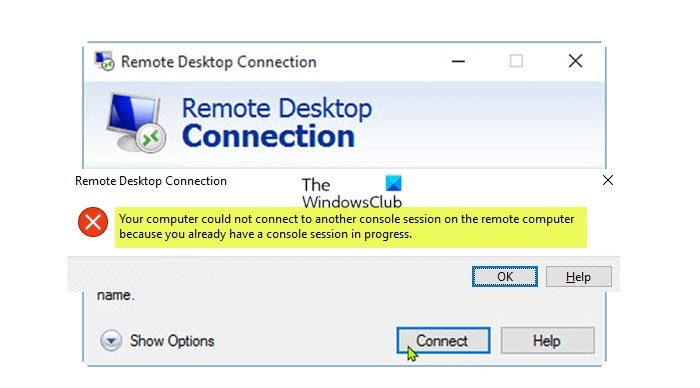When this issue occurs on your Windows 11/10 PC, you will receive an error prompt displaying the following full error message; Typically, you are most likely to encounter this error because one of the network adapters on the computer (source) you’re trying to remote connect from has the same IP address with the computer (destination) that you are trying to connect to via the remote desktop protocol.
Your computer could not connect to another console session
If you’re getting the error message Your computer could not connect to another console session on your Windows 11/10 computer, consequently preventing you from establishing a remote connection, you can try our suggestions below to have the issue resolved in no time! Let’s take a look at the description of the process involved concerning each of the listed solutions.
1] Initial checklist
Before you proceed with the solutions below, run through the following task and after completing each task, check to see if the issue in focus is resolved or not.
Reboot both local and remote machines. You can reboot the source computer and as well reboot the destination computer, then try the remote connection again.Check Task Manager. You can check for and kill all remote desktop related processes in Task Manager and see if the issue is resolved.Reset network connection. In some cases, the network both computers are on might be the culprit. So, you can release TCP/IP, Flush DNS, Reset Winsock, Reset Proxy and see if that helps.
2] Add affected users to the Remote Desktop Users or Administrators group
If you have ticked all the boxes on the initial checklist but the Your computer could not connect to another console session error is still not fixed on your Windows 11/10 computer, you can see if adding affected users to the Remote Desktop Users or Administrators group on the local computer solves the issue for you. To perform this task, you can follow the easy instructions in the guide on how to add or remove Remote Desktop users.
3] Change IP Address on source computer
As already indicated, if the local computer has the same IP address as the remote computer you’ll encounter the error in view. This potential solution requires you to change or assign a different IP Address on the local computer. To perform this task, you need to first run IPconfig, then make a note of the source computer IP address and then proceed to change the IP address accordingly (change only the digits of the fourth octet to a higher value than that of the remote computer IP address). If the IP address on your local network is assigned by a DHCP server, then you can try any of the following to workaround the issue:
Specify manually a different static IP address.Restart your router (DHCP server), so the local machine can lease a different IP Address from the DHCP server.Configure the DHCP server (e.g. on the router), to assign IP addresses in a range that does not include the IP address of the remote computer.
That’s it! Related post: Your computer can’t connect to the remote computer error on Windows
What is a console session?
The console session is what you see when you look at a monitor that’s plugged into the server. Normally with RDP, you get your own session that is not the same as what’s shown on the server’s own monitor. A typical example might be a backup application that is running on the console.
How do I stop a console session?
To close the Privileged Web Access Console Session or to exit an access session, click on the X icon in the top right corner of the screen. Next, you will receive a prompt asking if you would like to end the session. If you click OK, the session will end, and you will be directed back to the All Jump Items list.
Which command is used to connect to a server with administrative session?
To start a remote session for administrative purposes, start RDC from the Run dialog box or command prompt and add the /admin switch like this. You can also specify the /admin switch when adding connections to the RSAT.
How do I disconnect a user session remotely?
Click Start > Settings, then click the user name (top-right corner), and then click Sign out. The session ends and the station will now be available for log on by any user. Alternatively, click Start, > Settings, > Power, and then click Disconnect.

